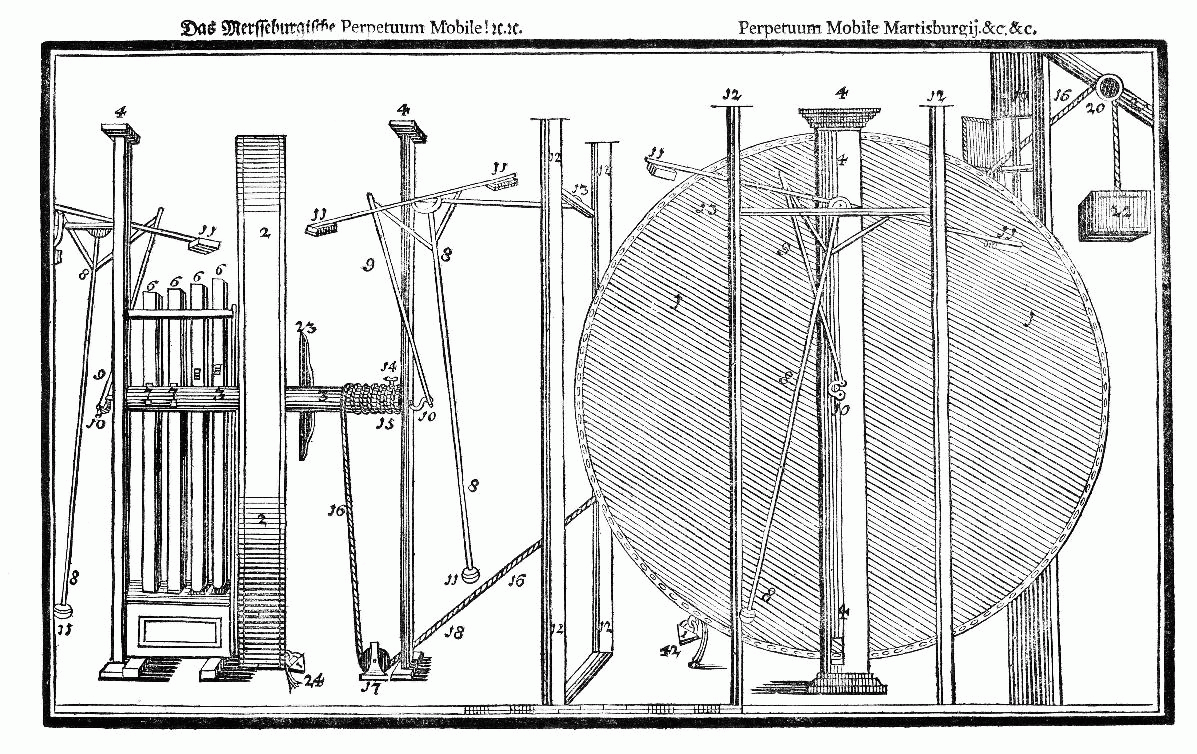In 1745, gravity finally caught up to the inventor Johann Bessler. After a career creating mysterious wheels that defied its pull, he fell to his death from a windmill.
He was destitute, not long out of jail for heresy, and his wife had left him. His inventions had baffled the greatest minds of his generation, and now his death left the world with a question that appeared unsolvable. How had one man in the early decades of the 18th century made a wheel that never stopped spinning? Or had it all been a con?
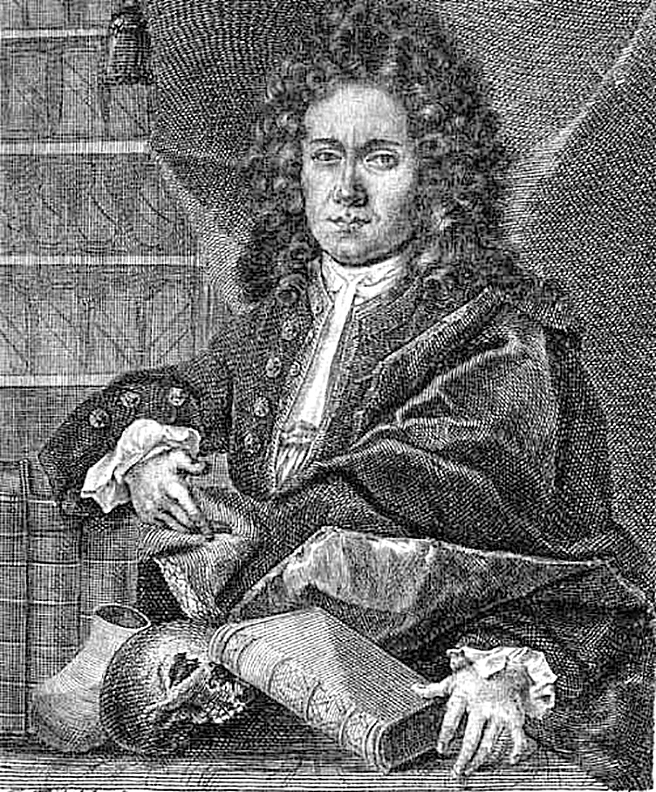
Johann Bessler. Photo: Wikimedia Commons
Bessler arrived on a stage perfectly set for scientific deception. A vicious feud between leading mathematicians Isaac Newton and Gottfried Leibniz in the early 18th century had split the physics world into factions. The feud originated in a debate over who had invented calculus. It turned out later that both had come up with it independently. But at the time, it spiraled into every aspect of the field, from what kept the planets orbiting the Sun to a messy controversy over momentum and energy.
Amid all the chaos, scientists were apt to leap onto whatever bandwagon might give their side an edge.
“Factionalism meant that scientists spent less time attempting to replicate the empirical results of free-fall experiments and more time interpreting existing results in a way that was favorable to their preferred accounts,” says Robert Ziegler, a Ph.D. candidate in Philosophy at the University of Virginia, whose research focuses on Leibniz.
If anyone was an expert at exploiting what scientists wanted to see, it was Johann Bessler.

Johann Bessler. Photo: Wikipedia
A questionable backstory
According to a late 18th-century biography of dubious reliability, Bessler’s rags-to-riches-to-rags story began in Zittau, where this peasant’s son showed such aptitude that he obtained a secondary education. By his own account, he excelled at everything mathematical. Yet after leaving school, he became an itinerant jack-of-all-trades, dabbling in everything from watchmaking to medicine.
His skills did not win him stability. Starving, he found sporadic work as a soldier and even lived for some time in a monastery simply to eat. He claimed to have rescued an alchemist from drowning in a well and learned the secrets of elixirs.
At some point in his wanderings, Bessler decided his name was not sufficiently cryptic, and so he chose the letters in the alphabet symmetrically opposite to those in his name — A was N, B was O, etc. He thus came up with the pseudonym Orffyre, which he then Latinized to Orffyreus. He used this as his professional name for the rest of his life.
When Bessler stopped in the town of Annaberg, the mayor, Christian Schuhmann, begged him to save the life of his ailing daughter. The mayor promised Bessler his daughter’s hand in marriage as a reward. One of the first certain facts of Bessler’s life is that he married Barbara Elisabeth Schuhmann in or around 1712. It introduced him to a comfortable, middle-class life.
The wheels that turned forever
Bessler used his newfound status to construct the first of his “perpetual motion” machines. He displayed this small wheel, three feet in diameter, at the city of Gera, in eastern Germany. It lifted pound-weights several feet into the air, seemingly powered by something internal to the wheel. Water wheels need water to turn; windmills use wind; modern motors require electricity — but this wheel didn’t seem to need anything. Still, it must not have impressed anyone much because he left for Leipzig shortly after. At Leipzig, he presented his second wheel, about double the size of the first and capable of lifting 40 lbs while maintaining a brisk spin.
What should one expect at a demonstration of Johann Bessler’s wheels? The usual exhibition involved Bessler giving the wheel a short push, whereupon it slowly gathered speed and then carried on at a maximum speed until asked to lift weights. When performing work, its speed decreased at first but then remained steady, as though it could continue turning forever.
Crashes and bangs rang out from somewhere within the concealed inner workings. Observers reported sounds as though of weights falling inside. On several occasions, they watched Bessler place metal cylinders behind the canvas covering. But anyone curious about the mechanisms of this machine would have to be content with the outside view. Bessler demanded £10,000 for knowledge of his machine, a nod to the prize offered by the British government for the discovery of longitude.
Praise and criticism
At that point, no one offered to pay £10,000 for such a suspicious invention. The Second Law of Thermodynamics states that you can’t get something for nothing. A wheel cannot turn without external input; weights cannot be lifted without a transfer of energy.
Although this formalism had yet to be developed, many prominent thinkers, including Leonardo da Vinci, had provided mathematical proofs against the idea that gravity alone could power a wheel to turn, much less lift weights without stopping. That would imply the wheel possessed an intrinsic source of self-renewing energy. Bessler claimed he harnessed gravity to turn the wheel, but proofs against “gravity mills” had existed for centuries.
Despite the prevailing consensus on perpetual motion, Bessler received an illustrious visitor at Leipzig — Gottfried Leibniz gave the wheel his stamp of approval. He even wrote to the court of Tsar Peter the Great about Bessler’s miraculous invention.
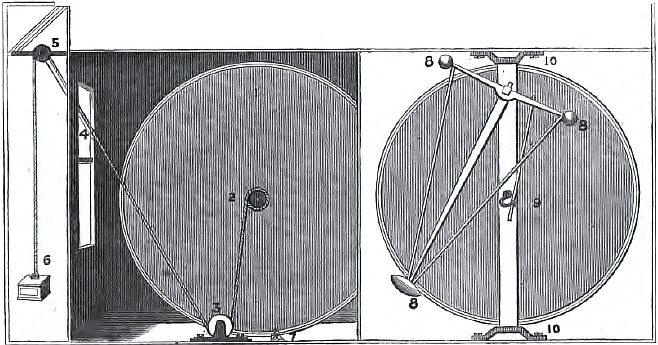
A closer view of the Merseburg wheel as it lifts a weight. Photo: Henry Dircks
If anything, the attention from Leibniz only concentrated the criticism against Bessler. He set up his next wheel in Merseburg and invited a panel of local literati to perform a comprehensive review. The Merseburg wheel was 12 feet in diameter and capable of lifting up to 70 lbs. The account of its performance is the most comprehensive description we possess of the functioning of Bessler’s wheel, including the speed of rotation and timing of loud noises from within.
The glory days
Whatever may be said of Johann Bessler’s legitimacy, he was not in the game for money. It was not until Merseburg that he monetized his wheel by asking for donations to charity. Even then, he did not require viewers to buy tickets, despite the city’s tax on his demonstrations. Years later, when someone actually offered him the £10,000 for his design, he pretended to be sick until they gave up.
In 1716, Prince Karl of Hesse-Kassel offered him patronage, so Bessler moved his household and built yet another wheel. He began promoting his invention in pamphlets. Finally, he faced his critics head-on when he enclosed his wheel in a windowless room and claimed it would still be running at the same speed a month later.
On Nov. 12, 1717, Prince Karl officially sealed the door. On Jan. 4, 1718, he and his attendants broke the seals. The wheel sat in the middle of the room, untroubled, revolving just as it had over a month before.

The castle at Weissenstein where Bessler took up residence. Photo: Wikimedia Commons
The Newtonian perspective
The majority of Bessler’s supporters in the early years were Leibnizians. This was about to change. The first to arrive was Johann Fischer, who found himself grudgingly impressed.
“I […] stopped the wheel with much difficulty…An attempt to stop it suddenly would raise a man from the ground,” Fischer wrote to fellow Newtonian philosopher and engineer John Desaguiliers. “Having stopped it in this manner, it remained stationary; and (here, Sir, is the greatest proof of it being a Perpetual Motion) I restarted it very gently…I observed that the rapidity of the wheel augmented little by little…and then it regained its former speed.”
Like all the others who had viewed the wheel, Fischer was at a loss to explain its motion. Shortly afterward, respected Dutch mathematician Willem ‘s Gravesande made his own trip to Kassel. (The ‘s prefix is a historical Flemish naming convention.)
In a letter to Isaac Newton, ‘s Gravesande wrote that he had inspected the axles upon which the wheel rested and was “firmly persuaded that nothing from without the wheel in the least contributes to its motion.”
The wheel fascinated ‘s Gravesande. He could not explain it, and disliked Bessler himself deeply, but he would become his most ardent supporter.
Upon examining the axles without Bessler present, ‘s Gravesande certified in a report that no external mechanism supplied power. Bessler didn’t wait to find out the contents of the report. As soon as he learned that ‘s Gravesande had observed the wheel without him, he smashed it to bits. Next to the pieces, he wrote on the wall that it was ‘s Gravesande’s “impertinent curiosity” that had driven him to this.
‘Cursed, damned, and lost’
By all accounts, Bessler was an unpleasant man. He was easily annoyed, prone to fits of rage, and disinclined to cooperate with others. If he was unpleasant as an associate, he must have been even worse as the man of the house. Perhaps this goes some way to explain why first his wife and then his maid, Anne Rosine Mauersbergerin, tried to convince the world that his wheel was a fraud.
In an official testimony in 1727, Mauersbergerin claimed she and others had turned the wheel via a crank from an adjacent room. Bessler, she said, had threatened to shoot her if she came clean.
To support her account, she provided an oath that Bessler had forced her to sign. It makes no mention of exactly what Mauersbergerin was supposed to conceal, but by signing it she swore that she would be “cursed, damned and lost before God and men, before temporal and eternal judgment, for the present time and for all eternity” if she ever discussed Bessler’s affairs or spoke ill of him.
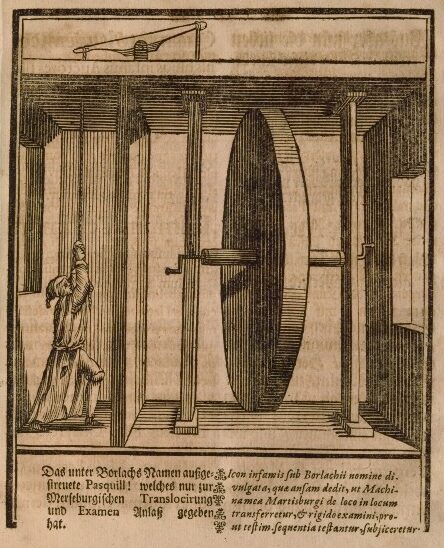
A woodcut published by Bessler refuting an earlier accusation that his wheels were powered by a crank. Photo: Max Planck Institute for the History of Science
What goes up…
Some of the greatest physicists of the time had inspected Bessler’s axles and come away certain that nothing in them drove the rotation of the wheel. Perhaps Mauersbergerin, uncertain of the true nature of the fraud, threw an easily understandable accusation at an abusive employer. Or perhaps Bessler had successfully disguised a mechanism in plain view.
If the wheel had been turned from an adjacent room, how was the motion so steady? How were weights of up to 70 lbs lifted? How had no one noticed the crank setup for the entire duration of the closed-room experiment? Was it the wheel itself that the crank turned or some mechanism within it that stored energy? Or was the nature of the fraud something else entirely?
The historical record is scarce, but it appears that many important scientists believed Mauersbergerin’s testimony. They shuffled Bessler out of view and ceased supporting his work, doing their best to ignore their own roles in his career.
The exception was ‘s Gravesande, who stood up for Bessler in face of changing public opinion. Bessler, disgraced and disregarded, turned from perpetual motion to another topical issue in 18th-century Germany: religion. In the early 1830s, he founded his own Church of Orffyreus. The authorities at Kassel promptly threw him in jail for heresy.
By the time he was released, his wife had left him. He retreated to his estate, where he pitched new contraptions to no avail and took mundane engineering jobs to pay the bills. In 1745, he began constructing a novel windmill that could turn no matter which way the wind blew. On Nov. 12, 1745, he fell to his death.
The believers
Exactly how Bessler so convincingly faked perpetual motion remains a mystery. The internet abounds with forums and personal websites devoted to uncritically perusing Bessler’s work. Even the author of the most well-researched book on Bessler believes in the truth of what he peddled. Those willing to dismiss the Second Law of Thermodynamics can find many potential designs for Bessler’s wheels, all based on his assertion that he had harnessed gravity.
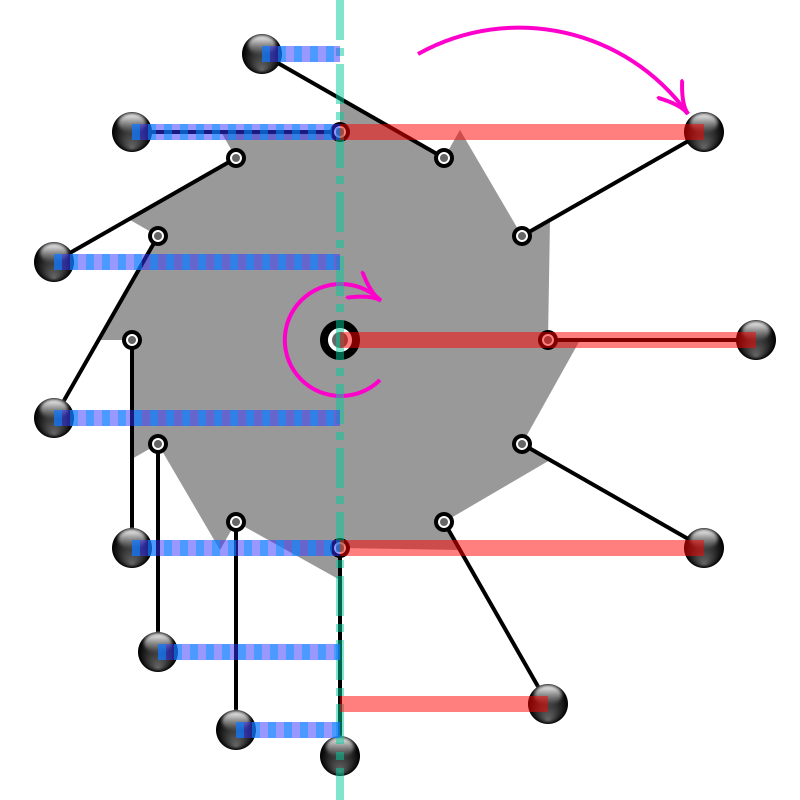
Diagram illustrating an overbalanced wheel, the archetypal and discredited model of a ‘gravity mill’-style perpetual motion machine. Photo: Wikimedia Commons
The disbelievers
But for once, the skeptics have mystique on their side. If Bessler did not discover gravity-based perpetual motion, whatever he did was an unmatched feat of deceptive engineering. It’s possible he used clockwork, and the sound of falling weights was a distraction from the true mechanism of rotation. The weights certainly played into his audiences’ expectations of gravity.
Then there’s the account of Anne Rosine Mauersbergerin and the crank. The crank might have wound a clockwork mechanism to store and release energy, or it might not have existed at all. But all we can say with confidence is that Bessler’s wheels depended on sleight-of-hand techniques coupled with an approximation of perpetual motion that, to this day, no one has recreated.
One skeptic devoted to analyzing Bessler’s work is Donald Simanek, a professor emeritus of Physics at Lock Haven University in Pennsylvania. Simanek has spent years carefully profiling and debunking physics misconceptions and hoaxes. Yet even he doesn’t know how to explain Bessler’s con.
“He must have had some way of re-energizing [the wheel] every time he changed the weights,” Simanek says. “But I don’t think we’ll ever know.”
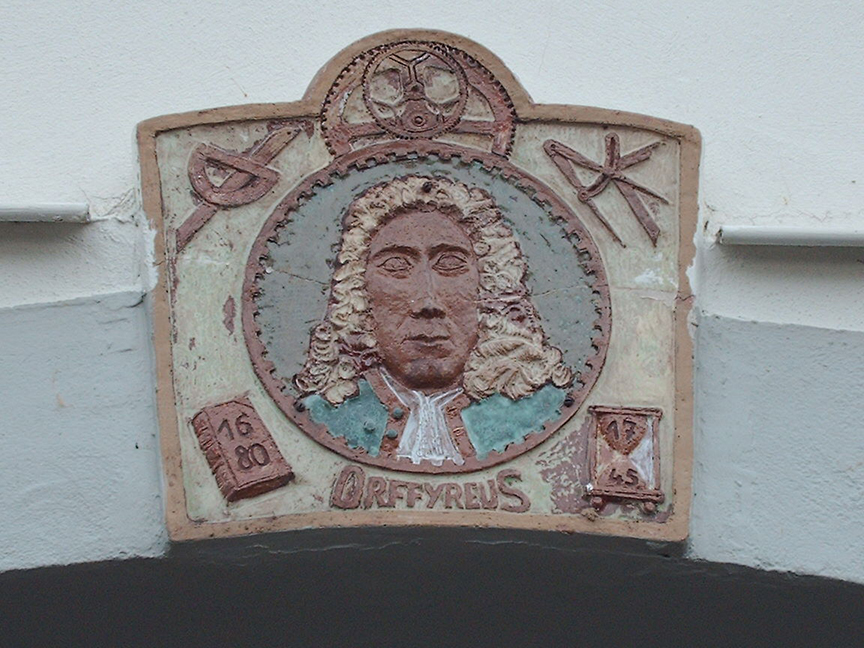
Rendering of Bessler above a door in his hometown. Photo: Wikipedia
